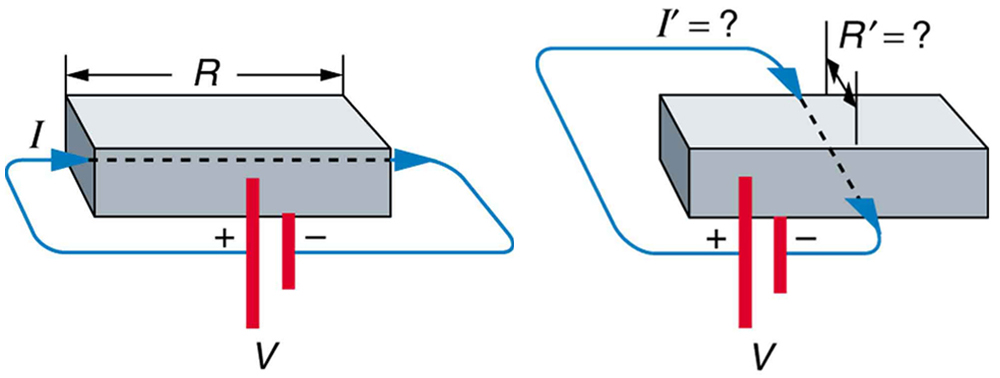| << Chapter < Page | Chapter >> Page > |
Using the PhET Simulation “Resistance in a Wire”, design an experiment to determine how different variables – resistivity, length, and area – affect the resistance of a resistor. For each variable, you should record your results in a table and then create a graph to determine the relationship.
Which of the following affect the resistivity of a wire?
The lengths and diameters of four wires are given as shown.

If the four wires are made from the same material, which of the following is true? Select two answers.
(b), (d)
Suppose the resistance of a wire is R Ω. What will be the resistance of another wire of the same material having the same length but double the diameter?
The resistances of two wires having the same lengths and cross section areas are 3 Ω and 11 Ω. If the resistivity of the 3 Ω wire is 2.65 × 10 −8 Ω∙m, find the resistivity of the 1 Ω wire.
9.72 × 10 −8 Ω∙m
The lengths and diameters of three wires are given below. If they all have the same resistance, find the ratio of their resistivities.
| Wire | Length | Diameter |
| Wire 1 | 2 m | 1 cm |
| Wire 2 | 1 m | 0.5 cm |
| Wire 3 | 1 m | 1 cm |
Suppose the resistance of a wire is 2 Ω. If the wire is stretched to three times its length, what will be its resistance? Assume that the volume does not change.
18 Ω
In which of the three semiconducting materials listed in [link] do impurities supply free charges? (Hint: Examine the range of resistivity for each and determine whether the pure semiconductor has the higher or lower conductivity.)
Does the resistance of an object depend on the path current takes through it? Consider, for example, a rectangular bar—is its resistance the same along its length as across its width? (See [link] .)

If aluminum and copper wires of the same length have the same resistance, which has the larger diameter? Why?
Explain why for the temperature variation of the resistance of an object is not as accurate as , which gives the temperature variation of resistivity .
What is the resistance of a 20.0-m-long piece of 12-gauge copper wire having a 2.053-mm diameter?
The diameter of 0-gauge copper wire is 8.252 mm. Find the resistance of a 1.00-km length of such wire used for power transmission.
If the 0.100-mm diameter tungsten filament in a light bulb is to have a resistance of at , how long should it be?
Find the ratio of the diameter of aluminum to copper wire, if they have the same resistance per unit length (as they might in household wiring).
What current flows through a 2.54-cm-diameter rod of pure silicon that is 20.0 cm long, when is applied to it? (Such a rod may be used to make nuclear-particle detectors, for example.)
(a) To what temperature must you raise a copper wire, originally at , to double its resistance, neglecting any changes in dimensions? (b) Does this happen in household wiring under ordinary circumstances?
A resistor made of Nichrome wire is used in an application where its resistance cannot change more than 1.00% from its value at . Over what temperature range can it be used?
Of what material is a resistor made if its resistance is 40.0% greater at than at ?
An electronic device designed to operate at any temperature in the range from contains pure carbon resistors. By what factor does their resistance increase over this range?
1.03
(a) Of what material is a wire made, if it is 25.0 m long with a 0.100 mm diameter and has a resistance of at ? (b) What is its resistance at ?
Assuming a constant temperature coefficient of resistivity, what is the maximum percent decrease in the resistance of a constantan wire starting at ?
0.06%
A wire is drawn through a die, stretching it to four times its original length. By what factor does its resistance increase?
A copper wire has a resistance of at , and an iron wire has a resistance of at the same temperature. At what temperature are their resistances equal?
(a) Digital medical thermometers determine temperature by measuring the resistance of a semiconductor device called a thermistor (which has ) when it is at the same temperature as the patient. What is a patient's temperature if the thermistor's resistance at that temperature is 82.0% of its value at (normal body temperature)? (b) The negative value for may not be maintained for very low temperatures. Discuss why and whether this is the case here. (Hint: Resistance can't become negative.)
Integrated Concepts
(a) Redo [link] taking into account the thermal expansion of the tungsten filament. You may assume a thermal expansion coefficient of . (b) By what percentage does your answer differ from that in the example?
(a) (total)
(b) 3.0% decrease
Unreasonable Results
(a) To what temperature must you raise a resistor made of constantan to double its resistance, assuming a constant temperature coefficient of resistivity? (b) To cut it in half? (c) What is unreasonable about these results? (d) Which assumptions are unreasonable, or which premises are inconsistent?

Notification Switch
Would you like to follow the 'College physics for ap® courses' conversation and receive update notifications?